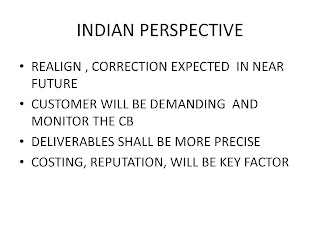The CD version is released and in a routine pace, this will
pass through the usual process of DIS, FDIS before release. The standard as
such is not only having some minor
corrections , but has new concepts.
Risk, Process approach, Context & Development process
are some major aspects in the standard. This will bring in major change in the
understanding, documenting and implementing the standard. All such changes will
bring in the quality management approach risk prevention, sustainability. The
standard is in line with ISO 9004 guidelines published some time back.
From the business perspective let us analyze the changes:
This is now a
management standard : With more focus on risk, prevention, strategy and
accountability of top management, the standard clarifies the tasks for top
management. In the earlier versions, the linkage between vision- strategy,
policy, objective was not mentioned , though expected. Here it is direct
linkage and there by onus will be more on management. This means management can
not handover to MR and remain aloof.
Focus on
sustainability: The context of organization identifies business related
external & internal aspects , risks. The impact and counter actions are
part of review. Hence this document will be guiding document and this will help
organization to improve.
Focus on Prevention
rather than QA/QC: The current standard
was clear on product monitoring and has
clear requirements related to process monitoring, product monitoring. The new
standard uses risk approach, strategy, Knowledge management, process approach
& context of organization. This will
bring in more focus on how to se all these to prevent product failures . The
standard has no change as far as current requirements of product monitoring.
Better quality
documentation: The process approach , the risk, knowledge management will
ensure that the documentation will be pertaining to the organization’s size and
purpose.
There are few areas which are different and made more
generic in order to accommodate service sector. These can have some impact
especially , clause on calibration , Management representative role are more simplified.
Let us see the not so
positive impact :
a.
This standard will further add some
documentation. Though useful , but may lead
a debate that earlier standard was more flexible, while this calls for
more, structured documentation.
b.
The small
organizations will find it difficult to prepare for unless some guidelines
are released. At the same time, big organizations will find it very useful,
only confidentiality can be an issue.
c.
The management clauses , context, and
strategy have some elements where there
can be debate as to what extent organization would want to document the
details. Adequacy, findings may not be
acceptable to the management.
d.
The same clauses when evaluated differently , may
lead to consultancy.
e.
The time required
for the audit is likely to go up – as documentation review, top management,
planning function need to be audited to the requirements.
Positive
Impacts:
a. Increased involvement of top management.
b. More of management audit, hence success
rate , sustainability of the organization will be better.
c.
Flexibility in the areas of monitoring,
calibration.
d.
Better understanding of preventive actions,
risk, strategy, improvements


















